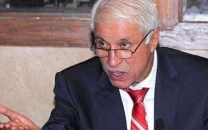Plan to raise $2b via Eurobonds
It will meet funding needs as foreign loans likely to remain thin

The government is planning to raise $2 billion through floating Eurobonds in the next fiscal year, as its foreign loan disbursement projections remain fluid in the absence of an International Monetary Fund (IMF) deal.
Due to the lack of clarity on the IMF front, the external debt inflows from the multilateral and bilateral creditors are estimated at only $6.2 billion for the next fiscal year, nearly 30% less than this year’s original estimate.
The estimate of $6.2 billion does not include any inflows on account of Eurobonds, commercial loans, and the IMF loan.
Sources in the Ministry of Finance said that the government was again considering raising $2 billion through Eurobonds during fiscal year 2023-24.
Its efforts to get financing from capital markets during the current fiscal year remained futile due to the junk credit rating assigned to Pakistan by three major international rating agencies.
However, Pakistan will have to win the trust of the IMF, if it wants to venture into capital markets. In the absence of IMF umbrella, it will be difficult to acquire new foreign commercial loans and issue sovereign bonds.
For the current fiscal year, Pakistan had expected the receipt of $3 billion from the IMF but it has so far got only $1.2 billion.
Sources said that during last week’s telephonic conversation with IMF Managing Director Kristalina Georgieva, Prime Minister Shehbaz Sharif floated the idea of extending the $6.5 billion loan programme. But sources said that the IMF told the premier that no further extension was possible for the current programme that would expire on June 30.
For the next fiscal year, the finance ministry is working on two scenarios,
with IMF and without IMF projections of foreign inflows.
Sources said that in the absence of an IMF scenario, the inflows would be too low and the government was placing its bets
on China.
The realistic assumption is that China can refinance $3.5 billion in foreign commercial loans and another $4 billion in deposits from the State Administration of Foreign Exchange (SAFE). But Pakistani authorities wanted to receive additional loans from China, said the sources.
Without the IMF umbrella, the combined foreign loan disbursements by the multilateral and bilateral creditors are estimated at $6.2 billion, which is not enough to meet the growing financing needs.
Sources said that the government was expecting $5.3 billion from the multilateral lenders in the next fiscal year, which was $2.3 billion less than this year’s original estimate.
Against this year’s original estimate of $2.6 billion, Pakistan is budgeting $2.3 billion in new loans from the World Bank in the next fiscal year.
Similarly, Pakistan expected $3.2 billion in loans from the Asian Development Bank (ADB) in the current fiscal year but for
the next year it is anticipating inflows of
$2 billion.
In the outgoing fiscal year, the government had budgeted $1.2 billion in short-term debt from the Islamic Development Bank (IDB). But for the next fiscal year, it is projecting only $500 million from the IDB.
Likewise, the country had received $579 million from the Asian Infrastructure Investment Bank (AIIB) in the current fiscal year. In the next year, it is expecting $361 million from the AIIB.
For fiscal year 2023-24, inflows from bilateral creditors are estimated at only $890 million compared to the estimate of $1 billion for this fiscal year.
Out of the $1 billion, $600 million is projected to come from Saudi Arabia on account of deferred oil payments. Chinese disbursement is projected at less than $20 million.
Official data showed that from July to April 2023, foreign loan disbursements amounted to $8 billion, reflecting a decrease of $4.8 billion, or 38%, compared to the same period of last fiscal year.
These disbursements have been insufficient to finance the maturing foreign debt, resulting in a significant dent in the country’s foreign exchange reserves, which currently stand at just $4 billion.
The primary cause of low disbursement is the government’s failure to ensure timely completion of the ninth review of IMF programme. Consequently, the receipt of $8 billion represents only 35% of the annual budget estimate of $22.8 billion.
Published in The Express Tribune, June 8th, 2023.
Like Business on Facebook, follow @TribuneBiz on Twitter to stay informed and join in the conversation.


















COMMENTS
Comments are moderated and generally will be posted if they are on-topic and not abusive.
For more information, please see our Comments FAQ